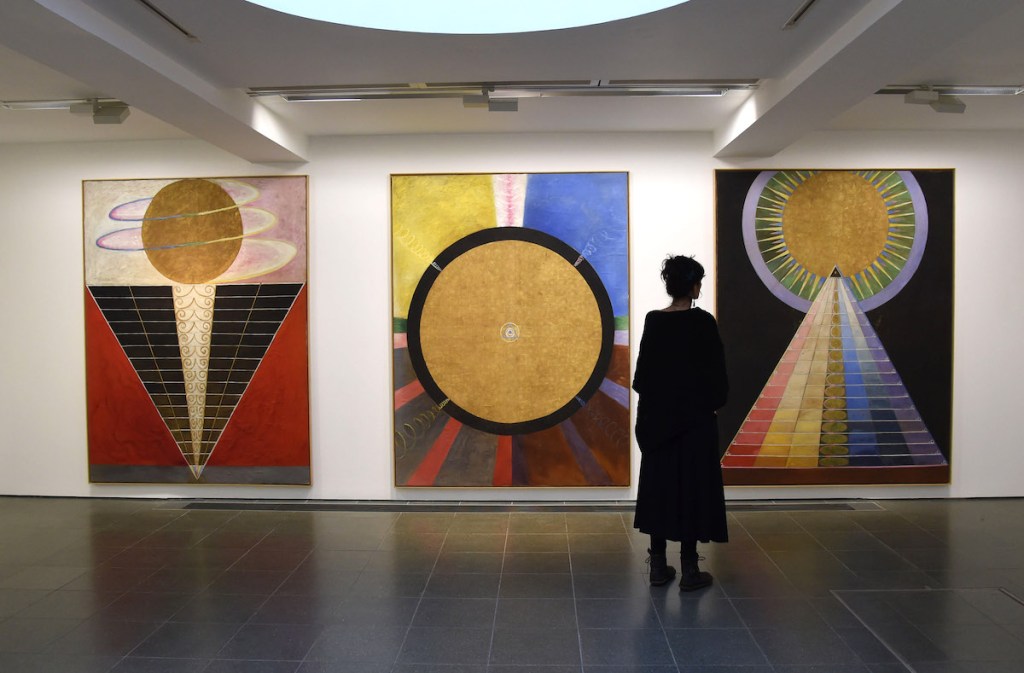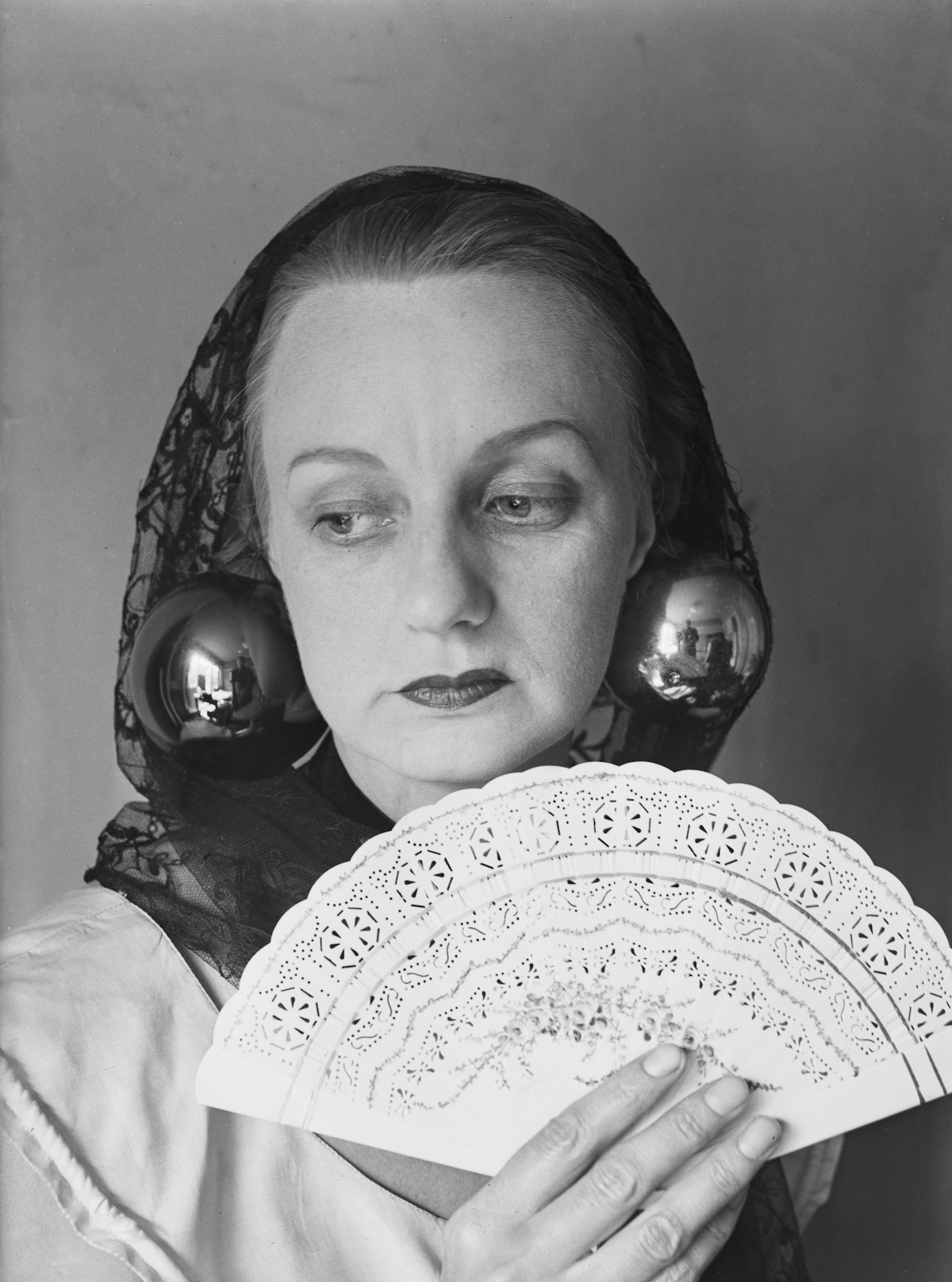
Photo David M. Benett/Getty Images
In 1936, Ithell Colquhoun showed alongside other British Surrealists in a London show devoted to the movement, effectively absorbing her into the group. By this point, she had painted otherworldly flowers and strange tableaux that had their roots in the Bible. Surrealism seemed like a good fit for all this dreamy imagery, but there was one problem: Colquhoun was an enrolled member of semi-secret occult societies.
By 1939, Colquhoun had broken with Surrealism, whose leaders didn’t believe occultism to be a valuable source of artistic inspiration. Perhaps Colquhoun left by her own volition, perhaps she was ejected from its ranks. Historians are unclear on what happened, exactly.
Time has vindicated her. In 2019, the Tate acquired Colquhoun’s entire 5,000-piece archive, labeling her a “key figure” of the Surrealist movement in its announcement. More well-known British Surrealists, like Roland Penrose and Paul Nash, cannot say the same for themselves—they are not nearly so well-represented in the Tate collection. The joke is on them.
Colquhoun’s art has moved inward, appearing not just at Tate but also in recent editions of biennials in Liverpool and Venice, too. If Colquhoun’s flirtations with occultism were formerly so taboo that not even the avant-garde would touch them, now her experiments with thought systems like theosophy seem all the more intriguing. Spiritual art like hers, once considered a taboo among critics too, has been embraced with open arms—and even etched into the history of modern art.
Colquhoun is one of the protagonists of Jennifer Higgie’s new book The Other Side: A History of Women in Art and the Spirit World, a survey of witchy women of the past two centuries who translated other realms into painting, photography, illustration, and dance. The chapter on Colquhoun follows a similar trajectory to the others: she begins as a mysterious figure (“a ghost, her eyes white in her shadowed face” in one Man Ray portrait), then comes into focus, then gets her due. Higgie attributes the slow recognition to the fact that Colquhoun was a true nonpareil: “She thumbed her nose at convention: she was bisexual, took lovers, didn’t have children, and while she believed in the power of the ‘divine feminine’ she held that at some time in the distant past masculine and feminine energies had been united.”
Colquhoun isn’t the only artist who didn’t fit within the confines of her day that Higgie explores. There’s Georgiana Houghton, whose spirit drawings filled with swirling abstract forms found an audience but few buyers—perhaps because “no one was making anything like this in the London art world of the 1860s,” as Higgie writes. There’s Helena Blavatsky, whose nonconformist Theosophy system inspired a host of modernists, from Piet Mondrian to Marcel Duchamp, but whose edgy beliefs may have kept her out of art history. And naturally, there’s Hilma af Klint, the Swedish abstractionist whose mystical imagery was supposedly dictated by otherworldly beings with whom she communed.

Ithell Colquhoun.
Photo Reg Speller/Fox Photos/Hulton Archive/Getty Images
What all these women have in common is that they’ve become fixtures in Western institutions in the past few years. Houghton is currently the subject of a show at Australia’s Art Gallery of NSW that finds a parallel for her drawings in the abstractions by Wassily Kandinsky, a much better-known artist. Blavatsky’s name recurs regularly in texts for exhibitions, including the 2018 retrospective for af Klint at New York’s Guggenheim Museum, which became the most well-attended show ever staged there. It turns out you can cram all this art referencing invisible worlds, spectral figures, and more into museum walls, those hallowed settings where art history is made.
Is there any way to free these women from the deadening force of the canon? Higgie makes a valiant attempt by writing something that is not necessarily a history. The Other Side broadly has a chronological structure, but it does not always move from Point A to Point B, as a textbook might. Partly, that is an attempt to reflect the very nature of this art itself, which, as Higgie points out, resists rationality and scientific study.
It’s worth quoting Higgie at length here: “For too long, these works were seen either as fascinating curios or sidelined or omitted from Western art history, despite the clear and documented reality of their existence. Even in art, reason, order and ambition were considered to be masculine traits; men were active and intellectual, whereas women were assumed to be passive, fragile and emotional. Many of the explorations and innovations of artists who happened to be women were seen as eccentric – although in the early days of modernism they often drank from the same spiritual well as their male contemporaries, many of whom were lauded.”
Take the case of Agnes Pelton, a member of the Transcendental Painting Group who painted works that she described as “little windows” into heretofore unseen universes. This American painter’s visions are vivid and gorgeous, filled with semi-translucent globes and starbursts that combine in twilit settings. This was simply too weird to exist within the confines of what institutions like the Museum of Modern Art had envisioned as being relevant, so Pelton didn’t make the cut. It wasn’t until 2023 that MoMA acquired a Pelton painting.
Georgiana Houghton, Glory be to God, July 5, 1864.
Courtesy Victorian Spiritualists’ Union, Inc., Melbourne
Higgie’s invocation of Pelton does not derive from a larger investigation into MoMA’s exclusionary history, although Higgie does go on to address that. Instead, it is spurred on by Higgie’s own travels in the Cyclades—specifically, the dusky period “when the hard edges of daylight begin to dissolve, the air cools, birds fall silent, and the indigo sea ripples with pinpricks of star light.” Higgie is not sure that Pelton visited this part of Greece, not that it matters much. The point is to create an art history that cannot be seen as objective, since it is so clearly filtered through Higgie’s own experience.
Higgie, an Australian-born critic who formerly served as an editor for Frieze, has written a book that blends multiple modes. It’s a memoir, a pandemic-era travelogue, and an art-historical inquiry all in one—which is unfortunately too much for this book to bear. The beaches of Greek isles contain an intensity that Higgie’s descriptions of art do not. Pelton and others in her ilk feel tamed as a result.
To a reader who has closely followed exhibitions like the 2022 Venice Biennale and the af Klint retrospective at the Guggenheim, almost all of the protagonists of The Other Side are familiar. That, too, is a shame, since the book accidentally ends up affirming a Eurocentric canon that has only recently welcomed women like af Klint. First Nations artists are only dealt with in a few pages; artists from the Global South remain on the sidelines. It is hard not to come away thinking that certain spiritualities still matter more than others.
Sprinkled throughout are reminders, however, that women artists with spiritual inclinations are still coming into focus. That means The Other Side is merely a first step in the right direction. There is still more work to be done.
Higgie even nods to this when she brings up Olga Fröbe-Kapteyn, a Dutch artist whom Higgie admits was entirely unfamiliar to her. Fröbe-Kapteyn’s abstractions formed from hard-edged shapes set against monochromatic backgrounds were intended to open portals to worlds beyond our own. Though the psychologist Carl Jung was among those who praised her work during her lifetime, Fröbe-Kapteyn remains lesser-known today. She’s never had a major retrospective.
“Despite having been immersed in thinking about art for the past four decades,” Higgie writes in the section on Fröbe-Kapteyn, “I’m constantly surprised by what I don’t know.” Hear, hear.